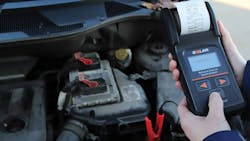The ultimate preventative maintenance: Test those batteries
We spend a good deal of time talking to customers, answering emails, and responding to blog comments, not to mention writing blogs and articles about the topic of preventive maintenance and proactive battery service. This most often places the focus on battery charging since modern batteries (AGMs, spiral wounds, etc.) benefit greatly from regular charging using a smart charger. While proactive charging will definitely bring benefit to your batteries and increase service life, there’s another preventive routine that delivers even more return for your time and effort, and that’s regularly testing your batteries. So, this month, we’re going to do a quick run-through on this beneficial routine.
Quick, easy, and painless
When we talk about a return on your time, we’re referring to how much benefit are you getting vs. the amount of effort you have to put into the routine. The good news when it comes to battery testing is that you get a ton of output in return for your input. Let’s start with the input. Using a digital battery tester, such as the SOLAR BA9, you can conduct a good battery test in less than three minutes from start to finish in most cases. That’s everything – finding the battery, making your connections, setting up the test routine, and running the test. If you want to also test the starting and charging systems, add two more minutes. Plus, it’s easy: just connect to the battery posts, positive to positive, negative to negative. And it’s safe, as our BA9 is equipped with reverse polarity protection, so if you make a wrong connection, just correct it before moving forward.
Now, let’s talk about the return for your testing effort. Regularly testing your battery(ies) provides insight into their health, helping you better understand where it/they are in the battery lifecycle and provides early warning when one is nearing the need for replacement. This is huge in several ways, but we’ll focus on the benefits of safety and convenience. A compromised battery definitely presents a safety concern, including the damage it can cause to other system components that interact with it. Separately, there’s a major convenience component in play when we are rolling around with a compromised battery. There’s nothing worse than turning the key (or pushing a button) and the vehicle not starting. For almost everyone, avoiding a no-start situation is worth its weight in gold, especially since no-start events always come at the worst possible time.
A few things to keep in mind
We’d like to share some pointers for this service routine to help you get the most benefit from it. First, whenever possible, connect directly to the battery post when making your connections rather than to the battery connection hardware. If you must connect to the hardware, make sure all hardware connections to the battery posts are tight and secure. A loose connection will add resistance and distort your results, potentially causing you to think your battery has an issue when it doesn’t. If you must connect to the hardware and the tester declares that your battery is compromised, we suggest disconnecting the battery and running a second test to confirm the result. Doing so ensures that connecting to the hardware didn’t negatively influence your results.
Second, when using a digital tester, make sure it has a specific testing routine for the battery type that you are testing. This is critical. For instance, testing an AGM battery using a flooded battery test routine is going to return inaccurate results pretty much every time. A digital tester is only as good as its internal judgment maps, and those maps are only accurate (in our opinion) when they are calibrated to a specific battery type since each battery type reacts differently to the pulses of energy that the tester sends through the battery during the testing process.
Finally, some vehicles equipped with Start-Stop systems (engine turns off when you come to a complete stop) have an architecture where they actually have two batteries, often with a primary starting battery in the engine compartment and a second “auxiliary” battery elsewhere, usually in a trunk side well. It is important to know if you have two batteries and, if so, what the battery type is for each. Often, they are not exactly the same from a testing standpoint. Unfortunately, a compromised auxiliary battery can disrupt the function of the primary starting battery. So, if you have two, test them both when you conduct your routine.
The value of digital testing
As we have noted in previous articles, modern batteries don’t have the same failure mode as they used to. If you learned to drive in the 1980s or 1990s, you became familiar with the tell-tale signs that your battery was heading into a death spiral. Longer, slower cranking…maybe 2-3 attempts before the engine turned over. Experience it once and you knew from then on. Today’s batteries fail differently, often with no warning signs. Good today, insufficient tomorrow, and you’re stuck. Beside the convenience they offer, digital testers have a major advantage over traditional invasive load testers in this area. Since they don’t just look at the result (can the tester hold the load in the moment?), by peering into the inner workings of the battery, digital testers have a predictive early warning capability that can alert you that your battery is about to fall off a cliff in terms of health and performance. This is very useful.
Why it matters for service shops
Until this point, the focus of this article has been on the benefits of preventive battery testing for vehicle owners and consumers. But they aren’t the only beneficiaries of such efforts. For shops, this practice has many benefits for you and your customers. In most shops, implementing a regimented preventive battery and system testing strategy is typically referred to as a “Test Every Vehicle” program. Such a program delivers tangible benefits for your customers since you’re doing for them what we suggest above. By sharing with the vehicle owner the results from such an effort, they are informed about the state of health of their electrical system and are warned about any impending problems. This is great customer service.
The benefit for your shop in implementing such a program is that it will increase revenue. It’s inevitable. Testing every vehicle for battery and system performance will result in a percentage of vehicles with compromised batteries, allowing you to have a conversation with your customer about why they might want to replace their battery (that means an additional sale). But there’s more! Testing will also uncover issues with rotating electrical components (starters, alternators), belts, and cable ends. Again, creating the chance to have important conversations with your customers about needed service on important systems helps them keep their vehicle running right and drives revenue for your business.
Add it up and battery testing just makes sense
There are few things worse than a vehicle that won’t start. While there are many causes for such a dilemma, the most common culprit is a weak or totally dead battery. The good news for vehicle owners and shops alike is that such an occurrence is largely preventable by implementing a regular battery testing routine. For vehicle owners, we suggest testing your battery(ies) once every 90 days or every 60 days if you live in an area like Phoenix or Vegas where extreme heat is common. For shops, we suggest implementing a regular service check of the battery and starting/charging system of every vehicle that comes in for service. As we’ve all experienced, sometimes painfully, batteries are perishable. Preventive testing allows a vehicle owner to manage their battery replacement cycle in the least cumbersome manner and eliminate the surprise hassle of a no-start situation.
About the Author

Jim O' Hara
Clore Automotive
Jim O'Hara has over 15 years experience in the Tool and Equipment industry, including 10+ years at Clore Automotive. At Clore, he heads up the marketing team and is directly involved in the development of new products and enhancements of existing products.
